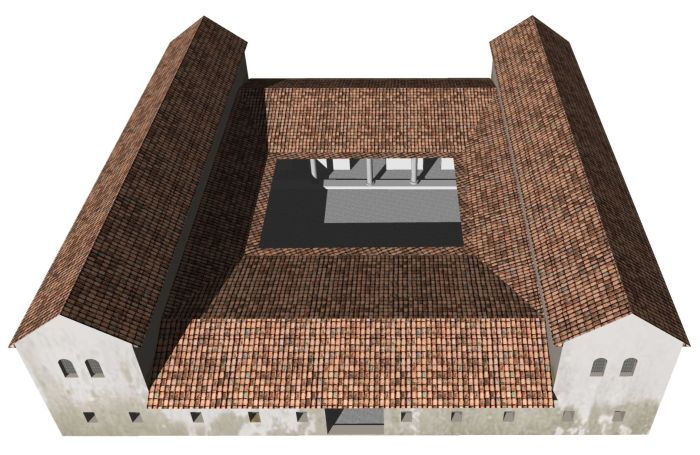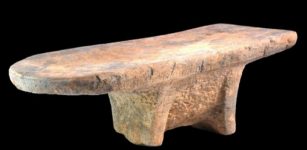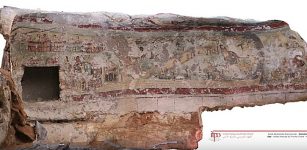LIDAR Disovers 2,000-Year-Old Roman Temple Under Church In Danilo, Croatia
Jan Bartek - AncientPages.com - A 2,000-year-old, large Roman temple has been discovered under and next to the Church of St. Daniel in the village of Danilo near Šibenik, the former Roman city of Ridit in Croatia.
The ancient building has massive walls and a rectangular outline (approx. 20 x 10 m). Georadar images show the frame of the entrance, according to scientists most likely in the form of relics of a colonnade.
View of the valley where the village of Danilo is currently located, in ancient times it was the city of Ridit/Municipium Riditarum. Credit: F. Welc.
As reported by PAP, "although archaeologists have been finding numerous architectural elements and decorations from the monumental Roman sacral building, until now its location was unknown.
Georadar survey around the church in Danilo, under which relics of the Roman sacral building were discovered. Credit: O. Orłowska
Polish research leader, Professor Fabian Welc from the Institute of Archaeology of the Cardinal Stefan Wyszyński University in Warsaw, said: “The data we have collected indicate that under today's church and the adjacent cemetery there are relics of a temple, which was part of the forum, the most important part of a Roman city."
Georadar survey in the area around the Danilo cemetery. Credit: A. Konestra
He added that the forum was the centre of the social and economic life of the inhabitants of every Roman municipium (city). This forum was located at the intersection of the main communication arteries and was also the central point in the city. In addition to the temple, it was the location of the most important public buildings of cities, such as courts or municipal offices. The forum was additionally decorated with monuments or triumphal arches.
Georadar survey in Danilo. Credit: A. Konestra
Next year, scientists plan to conduct archaeological research near the church to verify the findings of geophysical surveys. It is known that the current 18th-century church was built on the foundations of an earlier, small Romanesque Christian temple. Under it - according to the latest research - was the oldest, Roman temple.
The LIDAR aerial scanning technology was also helpful in locating the temple. It enables a very thorough analysis of the terrain and makes it possible to detect the remains of former architecture, very weakly outlined on the surface.
According to the scientists, not only the church was built on the ruins of the former temple. The nearby cemetery, which functioned from the 9th to the 15th century, was also partly located within its original range. Next to it were other buildings surrounding the forum. Some of the medieval graves were dug directly into the relics of the Roman baths along with the adjacent vast building with a central courtyard and a portico surrounded by numerous rooms.
Professor Welc said: “This means that the extensive medieval cemetery was founded directly on the relics of Roman buildings.”
The Croatian project coordinator, Dr. Ana Konestra added that thanks to large-scale geophysical surveying and analysis of the ALS model, a number of other Roman buildings were identified around the modern-day cemetery in Danilo. According to the archaeologists, they were mainly residential and utility buildings.
Reconstruction of a building with a courtyard made by Professor Fabian Welc.
Even before the recent surveys, there were suspicions concerning the location of the forum within the area of the cemetery, because reused fragments of monumental architectural decorations and a large column were discovered in the stone walls surrounding medieval graves.
Professor Welc said: “The very size of these elements indicated that somewhere near the cemetery there had to be a large, monumental building, which had to be part of a complex of buildings surrounding the city forum. However, previous excavations did not allow us to determine its location.”
See also: More Archaeology News
Archaeologists have been conducting research in Danilo for over 70 years. The first extensive work was associated with the construction of the water pipeline. It brought finds in the form of hundreds of Roman inscriptions, some of which mentioned Municipium Riditarum, an enigmatic city founded somewhere in Danilo by the local community of the romanised Ridit tribe.

A fragment of an ornamented monumental beaming of the Roman temple unearthed in the 1950s in the medieval cemetery in near the church in Danilo. Credit: F. Welc
The joint Polish-Croatian project started in 2019. It is carried out by researchers from the Institute of Archeology of the Cardinal Stefan Wyszyński University in Warsaw, the Institute of Archaeology in Zagreb and the Šibenik City Museum. The research is financed by all these institutions and the Polish National Science Centre.
Written by Jan Bartek - AncientPages.com Staff Writer







![Photo taken on Dec 20, 2015 shows hoof-shaped gold ware unearthed from the main coffin in the Haihunhou (Marquis of Haihun) cemetery, East China's Jiangxi province. [Photo/Xinhua]](https://www.ancientpages.com/wp-content/uploads/2015/12/MarquisofHaihuntomb1-307x150.jpg)

















